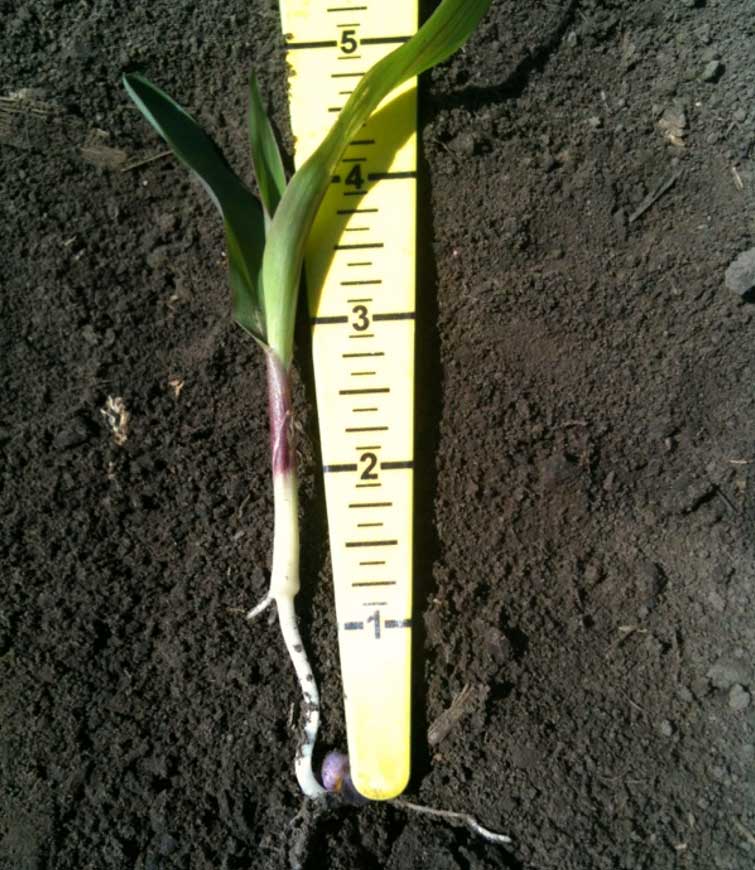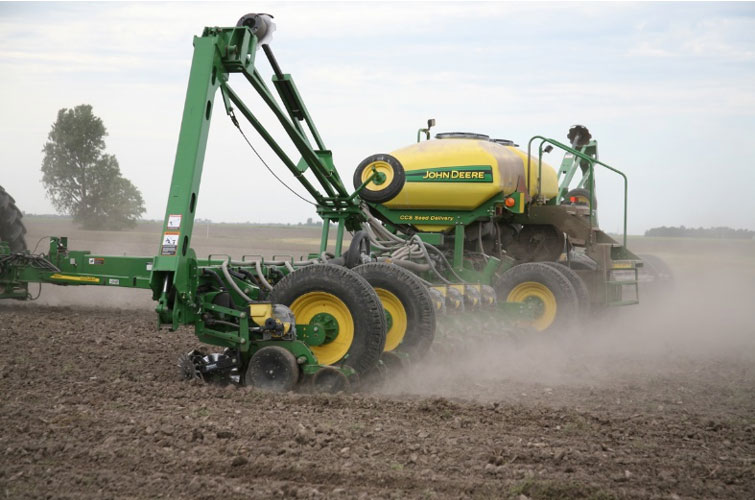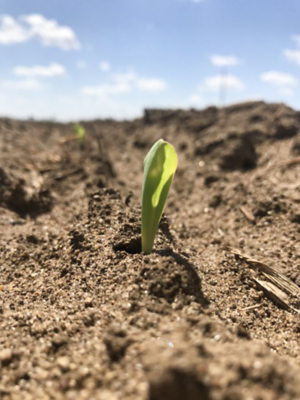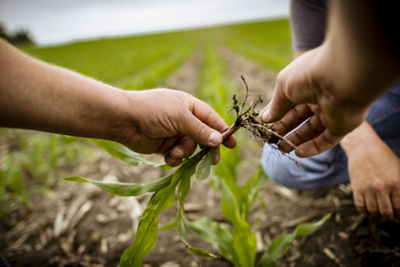Written by Mark Jeschke, Ph.D., Agronomy Manager
Crop Doctorate: Corn Planting Depth & Spacing
Which planting depth is best for different soil textures? We went to the field to find out.
Key Points
- Planting corn around 2 inches deep is likely to provide the best odds of success in most environments in the Corn Belt.
- Research has shown that planting corn at least 2 inches deep can improve uniformity of emergence by placing seeds into a more consistent seedbed and improving seed-to-soil contact.
- Corn planted less than 1.5 inches deep is susceptible to less-uniform emergence and poor nodal root development.
Related Articles
- Corn Planting Depth: Soil Temperature and Moisture Flux in the Furrow
- How Planting Depth and Soil Texture Affect Corn Emergence
- Planting Depth Effects on Corn Stand and Grain Yield
Common Planting Depth Recommendations
- University Extension guidelines in the U.S. Corn Belt commonly recommend planting corn 1.5 to 2.5 inches deep.
- Specific seeding depth recommendations within the 1.5- to 2.5-inch zone are often based on soil texture and moisture conditions, with shallower planting recommended for poorly drained, finer-textured soils and deeper planting recommended for well-drained, coarser-textured soils.

Figure 1. Corn plant at V1 that was seeded two inches deep, with growing point ¾ of an inch below the soil surface. Correct planting depth is important for normal root development.
Risks with Planting Too Shallow
- Planting corn too shallow can hamper nodal root development by placing the crown too close to the soil surface.
- Plants with poor root development are less able to take up water and nutrients and can suffer dramatically during periods of summer drought.
- In severe cases, corn can develop a condition called “rootless corn syndrome” in which plants will fall over due to the lack of nodal root development in dry soil near the surface.
- Shallow planting can expose corn seedlings to herbicide residues, increasing the potential for herbicide injury.
- Emergence may be less uniform due to a greater variability in moisture and temperature conditions in the seed bed and poorer seed-to-soil contact.

Figure 2. Rootless corn syndrome caused by shallow planting followed by dry soil conditions.
Risks with Planting Too Deep
- Planting too deep can be problematic when soils are cool and wet following planting, potentially resulting in uneven emergence and reduced stand establishment.
- Planting deeper can also place corn at a greater risk of emergence problems resulting from surface crusting if the field experiences a heavy rainfall event after planting.
- Crusting can affect corn planted at any depth, but deeper-planted corn can be at a slightly greater risk due to the slightly longer time it takes for seedlings to reach the surface and emerge.
- Crusting risk is greatest in finely textured soils, low organic matter soils, and fields with poor soil structure and minimal residue.
Key Findings from Recent Research
Ohio State Study (Lindsey and Thomison, 2020)
- Shallow planting (~1 inch) shortened the time to the start of corn emergence, but lengthened the duration of emergence resulting in a less uniform stand.
- Soil moisture was lower and more variable closer to the soil surface, which likely contributed to the less-uniform emergence with shallower planting.
- Planting depth affected yield in a higher organic matter field, but had no effect in a lower organic matter field.
Univ. of Missouri Study (Kitchen et al., 2021a,b)
- Planting corn at the deeper end of the recommended range (2.5 to 3.0 inches) was advantageous for corn emergence in both coarse- and fine-textured soils.
- Planting deeper usually resulted in greater emergence uniformity and similar or improved corn emergence rates.
- Deeper planting (2.5-3.0 inches) was favorable for emergence rate and uniformity when temperatures after planting were warm, but was unfavorable in one year of the study when temperatures were colder.
How to Measure Corn Planting Depth
- Planting depth can easily be determined after seedling emergence.
- The nodal root area (crown or growing point) typically develops about ¾ of an inch beneath the soil surface regardless of the seeding depth.
- Measure the mesocotyl length (the area between the seed and crown or growing point, then add ¾ inch to determine the planting depth.

Figure 3. Corn seedling showing how to assess depth of seed placement after planting by measuring from the seed to the nodal roots.
Corn Planting Depth Recommendations
- Research has generally shown that, within the standard recommended planting depth range (1.5 to 2.5 inches), there is more risk associated with planting too shallow than too deep.
- Corn should never be planted less than 1.5 inches deep.
- A target planting depth of around 2 inches is likely to provide the best odds of success in most situations in the Corn Belt.
- Deeper planting (2.5-3.0 inches) may be necessary in lighter, sandier soils in order to place seeds into consistent soil moisture.

Best Practices for Uniform Planting Depth
- Set the planting depth in the field, with the planter being pulled at full operating speed.
- Check for good seed-soil contact; strive for firm seedbeds that promote uniform emergence and stronger root systems.
- Maintain slower planting speeds, between 4 to 5 mph, to achieve more uniform planting depths.
- Utilize in-row residue managers where needed, especially in corn-following-corn rotations.
- Utilize a planter down force control system.
References
- Landscape Position Effects on Corn Emergence. Pioneer Agronomy Kitchen, N., S. Stewart, L. Conway, M. Yost, and P. Carter. 2021a. How Planting Depth and Soil Texture Affect Corn Emergence. Pioneer Agronomy Research Update 11:5.
- Kitchen, N., S. Stewart, L. Conway, M. Yost, and P. Carter. 2021b. Planting Depth and Research Update 11:6.
- Lindsey, A., and P. Thomison. 2020. Corn Planting Depth: Soil Temperature and Moisture Flux in the Furrow. Pioneer Agronomy Research Update 10:3.
Preparing to Plant Corn?
More insights for your corn acres.

Which Planting Outcomes Impact Yield?
Planning and execution in corn planting are critical to maximize the genetic potential of today’s elite corn hybrids.

Corn Planting Depth and Soil Texture
Does soil texture affect the ideal corn planting depth? This study went to the field to find out.
The foregoing is provided for informational use only. Please contact your Pioneer sales professional for information and suggestions specific to your operation. Product performance is variable and depends on many factors such as moisture and heat stress, soil type, management practices and environmental stress as well as disease and pest pressures. Individual results may vary. Pioneer® brand products are provided subject to the terms and conditions of purchase which are part of the labeling and purchase documents.